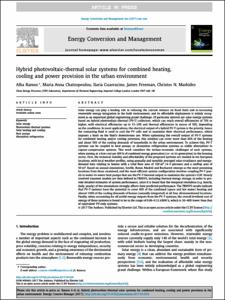Mostra el registre d'ítem simple
Hybrid photovoltaic-thermal solar systems for combined heating, cooling and power provision in the urban environment
| dc.contributor.author | Ramos Cabal, Alba |
| dc.contributor.author | Chatzopoulou, Maria Anna |
| dc.contributor.author | Freeman, James |
| dc.contributor.author | Markides, Christos |
| dc.contributor.other | Universitat Politècnica de Catalunya. Departament d'Expressió Gràfica a l'Enginyeria |
| dc.date.accessioned | 2019-07-10T06:29:40Z |
| dc.date.available | 2019-07-10T06:29:40Z |
| dc.date.issued | 2017 |
| dc.identifier.citation | Ramos, A. [et al.]. Hybrid photovoltaic-thermal solar systems for combined heating, cooling and power provision in the urban environment. "Energy conversion and management", 2017, vol. 150, p. 838-850. |
| dc.identifier.issn | 0196-8904 |
| dc.identifier.uri | http://hdl.handle.net/2117/165886 |
| dc.description.abstract | Solar energy can play a leading role in reducing the current reliance on fossil fuels and in increasingrenewable energy integration in the built environment, and its affordable deployment is widely recog-nised as an important global engineering grand challenge. Of particular interest are solar energy systemsbased on hybrid photovoltaic-thermal (PV-T) collectors, which can reach overall efficiencies of 70% orhigher, with electrical efficiencies up to 15–20% and thermal efficiencies in excess of 50%, dependingon the conditions. In most applications, the electrical output of a hybrid PV-T system is the priority, hencethe contacting fluid is used to cool the PV cells and to maximise their electrical performance, whichimposes a limit on the fluid’s downstream use. When optimising the overall output of PV-T systemsfor combined heating and/or cooling provision, this solution can cover more than 60% of the heatingand about 50% of the cooling demands of households in the urban environment. To achieve this, PV-Tsystems can be coupled to heat pumps, or absorption refrigeration systems as viable alternatives tovapour-compression systems. This work considers the techno-economic challenges of such systems,when aiming at a low cost per kW h of combined energy generation (co- or tri-generation) in the housingsector. First, the technical viability and affordability of the proposed systems are studied in ten Europeanlocations, with local weather profiles, using annually and monthly averaged solar-irradiance and energy-demand data relating to homes with a total floor area of 100 m2(4–5 persons) and a rooftop area of50 m2. Based on annual simulations, Seville, Rome, Madrid and Bucharest emerge as the most promisinglocations from those examined, and the most efficient system configuration involves coupling PV-T pan-els to water-to-water heat pumps that use the PV-T thermal output to maximise the system’s COP. Hourlyresolved transient models are then defined in TRNSYS, including thermal energy storage, in order to pro-vide detailed estimates of system performance, since it is found that the temporal resolution (e.g. hourly,daily, yearly) of the simulations strongly affects their predicted performance. The TRNSYS results indicatethat PV-T systems have the potential to cover 60% of the combined (space and hot water) heating andalmost 100% of the cooling demands of homes (annually integrated) at all four aforementioned locations.Finally, when accounting for all useful energy outputs from the PV-T systems, the overall levelised cost ofenergy of these systems is found to be in the range of 0.06–0.12€/kW h, which is 30–40% lower than thatof equivalent PV-only systems |
| dc.format.extent | 13 p. |
| dc.language.iso | eng |
| dc.publisher | Elsevier |
| dc.rights | Attribution-NonCommercial-NoDerivs 3.0 Spain |
| dc.rights.uri | http://creativecommons.org/licenses/by-nc-nd/3.0/es/ |
| dc.subject | Àrees temàtiques de la UPC::Energies::Energia solar fotovoltaica |
| dc.subject.lcsh | Solar energy |
| dc.subject.lcsh | Heat pumps |
| dc.subject.lcsh | Solar thermal energy |
| dc.subject.other | Solar energy |
| dc.subject.other | Photovoltaic-thermal systems |
| dc.subject.other | Solar heating and cooling |
| dc.subject.other | Heat pumps |
| dc.subject.other | Absorption refrigeration |
| dc.title | Hybrid photovoltaic-thermal solar systems for combined heating, cooling and power provision in the urban environment |
| dc.type | Article |
| dc.subject.lemac | Energia solar |
| dc.subject.lemac | Energia tèrmica solar |
| dc.subject.lemac | Bombes de calor |
| dc.identifier.doi | 10.1016/j.enconman.2017.03.024 |
| dc.description.peerreviewed | Peer Reviewed |
| dc.relation.publisherversion | https://www.sciencedirect.com/science/article/pii/S0196890417302273 |
| dc.rights.access | Open Access |
| local.identifier.drac | 25152076 |
| dc.description.version | Postprint (updated version) |
| local.citation.author | Ramos, A.; Chatzopoulou, M. A.; Freeman, J.; Markides, C. N. |
| local.citation.publicationName | Energy conversion and management |
| local.citation.volume | 150 |
| local.citation.startingPage | 838 |
| local.citation.endingPage | 850 |
Fitxers d'aquest items
Aquest ítem apareix a les col·leccions següents
-
Articles de revista [345]
-
Articles de revista [149]


